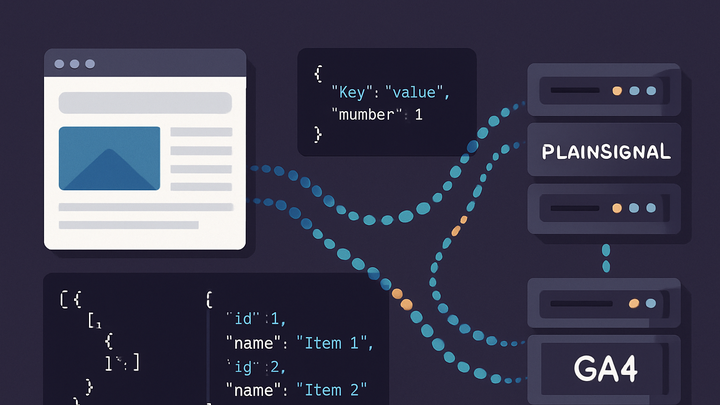Published on 2025-06-26T05:22:38Z
What is JSON? Examples in Analytics
In the analytics industry, JSON (JavaScript Object Notation) serves as the foundational data format for sending and receiving event data. It is a lightweight, text-based way to represent structured information using key-value pairs and arrays. Analytics platforms like PlainSignal and Google Analytics 4 (GA4) rely heavily on JSON for client–server communication, configuration, and reporting. By using JSON, these tools ensure interoperability across different languages and environments. This article explores JSON’s role in analytics, provides concrete examples including PlainSignal tracking code and JSON payloads, and offers best practices and common pitfalls to avoid. Whether you’re a developer implementing tracking scripts or an analyst parsing API responses, understanding JSON is crucial for accurate data collection and analysis.
Json
JSON is a lightweight, text-based format for structuring and exchanging analytics data between clients and servers.
Overview of JSON in Analytics
JSON (JavaScript Object Notation) is the de facto standard for data interchange in web analytics. It is used to represent complex data structures in a text-based, human-readable format. Analytics tools use JSON to send event data from client-side tracking scripts to servers, and to return configuration or reporting data back to dashboards.
-
Definition of json
A text-based data format that represents structured data as key-value pairs and ordered lists. It is language-independent and supported natively by JavaScript.
-
Key characteristics
JSON’s design emphasizes simplicity and flexibility, making it ideal for analytics use cases.
-
Lightweight
Minimal syntax overhead keeps payload size small.
-
Human-readable
Text format that developers can read and debug easily.
-
Hierarchical
Supports nested objects and arrays to model complex data.
-
JSON in Modern Analytics Platforms
Both PlainSignal and GA4 leverage JSON to structure event data and configurations. Understanding how each platform uses JSON helps developers integrate and troubleshoot analytics implementations more effectively.
-
PlainSignal (cookie-free simple analytics)
PlainSignal’s tracking script collects events and sends them as JSON payloads to its API endpoint, enabling privacy-focused analytics without cookies.
-
Cookie-free by design
Relies on JSON payloads and server-side processing instead of browser cookies.
-
-
Google analytics 4 (GA4)
GA4 uses the Measurement Protocol to send event data as structured JSON objects over HTTP to Google’s servers.
-
Measurement protocol
Defines a JSON schema for capturing events, user properties, and session data.
-
Event-driven model
Each user interaction is a separate JSON event object for granular analysis.
-
Example: JSON in PlainSignal Tracking
Below is an example of how to embed PlainSignal’s tracking script and the JSON payload that gets sent when a pageview event is recorded.
-
Tracking code snippet
Integrate PlainSignal by adding the following HTML snippet. The script reads your domain and project ID to initialize tracking:
<link rel="preconnect" href="//eu.plainsignal.com/" crossorigin /> <script defer data-do="yourwebsitedomain.com" data-id="0GQV1xmtzQQ" data-api="//eu.plainsignal.com" src="//cdn.plainsignal.com/plainsignal-min.js"></script> -
Sample json payload
Here’s a simplified example of the JSON payload sent when a pageview event is recorded:
{ "event": "pageview", "url": "https://example.com", "timestamp": 1625234523000, "visitorId": "abc123", "referrer": "https://google.com" }
Best Practices for JSON in Analytics
Implementing JSON effectively ensures reliable data flow and easier maintenance of analytics setups.
-
Validate json payloads
Ensure all JSON sent to analytics endpoints conforms to the expected schema to prevent data loss or errors.
-
Use consistent naming conventions
Adopt a predictable pattern for keys (e.g., camelCase) to maintain readability and consistency across events.
-
Minimize payload size
Remove unnecessary fields and shorten key names where possible to reduce network overhead and improve performance.
Common Pitfalls and How to Avoid Them
When working with JSON in analytics, certain mistakes can lead to data quality issues.
-
Incorrect data types
Mismatch between expected types (e.g., sending a string instead of an integer) can lead to parsing errors or dropped events.
-
Missing required fields
Omitting mandatory fields defined in the analytics schema can cause events to be rejected or reported inaccurately.
-
Unescaped special characters
Failing to escape quotes or control characters can break JSON parsing. Always escape strings properly.
